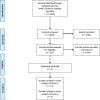Impaired processing of threat in psychopathy: A systematic review and meta-analysis of factorial data in male offender populations
- PMID: 31661520
- PMCID: PMC6818800
- DOI: 10.1371/journal.pone.0224455
Impaired processing of threat in psychopathy: A systematic review and meta-analysis of factorial data in male offender populations
Abstract
Background: Psychopathy is a personality disorder characterised by two underlying factors. Factor 1 (affective and interpersonal deficits) captures affective deficits, whilst Factor 2 (antisocial and impulsive/disorganised behaviours) captures life course persistent antisocial behaviours. Impaired processing of threat has been proposed as an aetiologically salient factor in the development of psychopathy, but the relationship of this impairment to the factorial structure of the disorder in adult male offenders is unclear.
Objectives: To investigate whether threat processing deficits are characteristic of psychopathy as a unitary construct or whether such deficits are specifically linked to higher scores on individual factors.
Data sources: A systematic review of the literature was conducted by searching PubMed, Web of Science and PsycINFO.
Methods: Studies were included if they (1) reported physiological measures of threat response as the primary outcome measure (2) indexed psychopathy using a well-validated clinician rated instrument such as the PCL-R (3) investigated male offenders between 18 and 60 years of age (4) reported threat processing analyses using both Factor 1 and Factor 2 scores (5) provided sufficient data to calculate effect sizes and (6) were published in English-language peer-reviewed journals. We identified twelve studies with data on 1112 participants for the meta-analysis of the relationship with Factor 1 scores, and nine studies with data on 801 participants for the meta-analysis of the relationship with Factor 2 scores. We conducted the meta-analyses to calculate correlations using random-effects models.
Results: PCL-R/SV Factor 1 scores were significantly and negatively related to threat processing indices (r = -0.22, (95%CI [-0.28, -.017]). Neither PCL-R/SV Factor 2 scores (r = -0.005, 95%CI [-0.10, 0.09]), nor PCL-R total score (r = -0.05, (95%CI [-0.15, -0.04]) were related to threat processing indices. No significant heterogeneity was detected for the Factor score results.
Conclusions: The meta-analyses of the distinct psychopathy factors suggest that the threat processing deficits observed in male offenders with psychopathy are significantly associated with higher scores on Factor 1. A similar relationship does not exist with Factor 2 scores. Our findings highlight the importance of investigating the potentially discrete relationships between aetiological variables and the two factor constructs in the disorder.
Conflict of interest statement
The authors have declared that no competing interests exist.
Figures





Similar articles
-
Psychopathy and impulsivity: The relationship of psychopathy to different aspects of UPPS-P impulsivity.Psychiatry Res. 2019 Feb;272:474-482. doi: 10.1016/j.psychres.2018.12.155. Epub 2018 Dec 29. Psychiatry Res. 2019. PMID: 30611967
-
Psychopathy and personality. An investigation of the relationship between the NEO-Five Factor Inventory (NEO-FFI) and the Psychopathy Checklist-Revised (PCL-R) in a hospitalized sample of male offenders with personality disorder.Crim Behav Ment Health. 2008;18(4):216-23. doi: 10.1002/cbm.699. Crim Behav Ment Health. 2008. PMID: 18803292
-
[Psychopathy and associated personality disorders: searching for a particular effect of the borderline personality disorder?].Encephale. 2010 Jun;36(3):253-9. doi: 10.1016/j.encep.2009.07.004. Epub 2009 Sep 26. Encephale. 2010. PMID: 20620268 French.
-
Psychopathy/antisocial personality disorder conundrum.Aust N Z J Psychiatry. 2006 Jun-Jul;40(6-7):519-28. doi: 10.1080/j.1440-1614.2006.01834.x. Aust N Z J Psychiatry. 2006. PMID: 16756576 Review.
-
Risk reduction treatment of psychopathy and applications to mentally disordered offenders.CNS Spectr. 2015 Jun;20(3):303-10. doi: 10.1017/S1092852915000322. CNS Spectr. 2015. PMID: 25997606 Review.
Cited by
-
Psychometrics, interpretation and clinical implications of hierarchical models of psychopathology.World Psychiatry. 2021 Feb;20(1):68-69. doi: 10.1002/wps.20813. World Psychiatry. 2021. PMID: 33432748 Free PMC article. No abstract available.
-
Putting the usability of wearable technology in forensic psychiatry to the test: a randomized crossover trial.Front Psychiatry. 2024 Jun 14;15:1330993. doi: 10.3389/fpsyt.2024.1330993. eCollection 2024. Front Psychiatry. 2024. PMID: 38947186 Free PMC article.
-
Promoting a Safe Environment in Our Cities: Towards a Theoretical Model of "Moral Deficit" for Appropriate Psychopathic Therapy.Int J Environ Res Public Health. 2020 Jul 10;17(14):4968. doi: 10.3390/ijerph17144968. Int J Environ Res Public Health. 2020. PMID: 32664190 Free PMC article.
-
Instruments of Child-to-Parent Violence: Systematic Review and Meta-Analysis.Healthcare (Basel). 2023 Dec 18;11(24):3192. doi: 10.3390/healthcare11243192. Healthcare (Basel). 2023. PMID: 38132082 Free PMC article. Review.
-
The novel narrative technique uncovers emotional scripts in individuals with psychopathy and high trait anxiety.PLoS One. 2023 Mar 23;18(3):e0283391. doi: 10.1371/journal.pone.0283391. eCollection 2023. PLoS One. 2023. PMID: 36952499 Free PMC article.
References
-
- Hare RD. The psychopathy checklist–Revised. Toronto, ON. 2003.
Publication types
MeSH terms
Grants and funding
LinkOut - more resources
Full Text Sources
Medical

